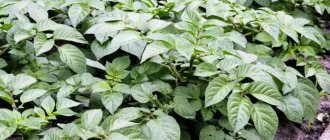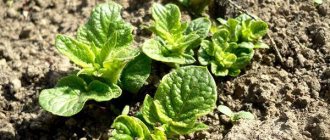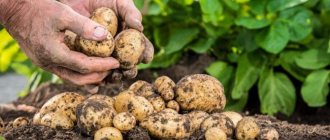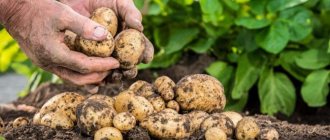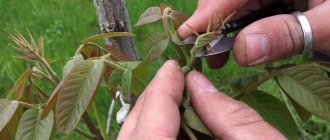Potato yield and its taste largely depend on how the soil was prepared. Experienced gardeners know this and begin work immediately after harvesting the crop, without postponing the event until the spring.
We’ll tell you what points you need to pay attention to when fertilizing the soil for potatoes in the fall. Let's talk about which substances can be added before winter, and which ones are best avoided at this time of year. We will give the consumption standards for organic and mineral fertilizers.
Timing for applying fertilizers in the fall
In this case, it is impossible to give exact dates. Fertilizers must break down into substances accessible to the plant, and this occurs only under the influence of the vital activity of soil bacteria. Therefore, you need to have time to add nutrients before the first frost.
To restore soil fertility in the area allocated for potatoes, fertilizers are applied in September, and in some regions in October. It is necessary that at least 2-3 weeks pass before negative temperatures. Then most of the substances will be available for absorption.
There is a simple way to determine deadlines. Once you have dug up the potatoes, start preparing a new plot.
Why fertilize the soil for potatoes in the fall?
Potatoes are a vegetable crop that is considered to be quite demanding on soil fertility. Without fertilizing, it is difficult to get a rich harvest. Experienced gardeners recommend preparing the area for spring planting potatoes in the fall. Organic substances introduced into the soil have time to rot over the winter and become easily digestible for plants. Mineral compounds partially decompose during the winter, and the acid-base balance returns to normal. If you apply fertilizer before planting potatoes, this can lead to a decrease in yield.
Application of organic fertilizers in autumn
Organic is the best option for areas that are intended for planting potatoes in the spring. This crop also responds positively to mineral fertilizers, but the best results are obtained when there is a thick layer of humus. It can only be formed by adding humus, manure and other organic means.
Local creation of humus
This method is used for small areas. It allows you to obtain a bountiful potato harvest without the use of mineral fertilizers throughout the season.
The work is carried out in the following sequence:
- Mark where the rows will be located.
- Dig trenches along them, about 30 cm deep and wide.
- Plant residues are placed at the bottom.
- Sprinkle with a thin layer of earth.
- Water with microbiological preparations - “Baikal” or “Siyanie” are suitable.
During the winter, the biomass, under the influence of bacteria, turns into nutritious humus, so important for potatoes.
Do not place nightshade tops or weeds with seeds in trenches.
Applying fresh manure
Any manure except pig manure can be applied to potatoes. Mullein or horse manure are ideal for these purposes; goat, rabbit and other types of waste will have less effect. Pig manure can be used only after complete rotting, and this takes at least 1.5 years.
When manure is debated, it generates heat, which attracts pests from all over the area. To prevent this, applying manure is permissible after the first frost. Better - a few days before severe frosts. The manure consumption rate is from 0.5 to 10 kg per square meter. It depends on its type and frequency of application.
Cow dung is good for potatoes. It contains a lot of nitrogen, calcium, potassium, magnesium and phosphorus. It is better to use not fresh manure, which may contain helminth eggs, but rather one that has been aged for at least 3–4 months. Its consumption rate when applied annually is 0.5 kg per square meter, when applied once every 3 years - 1 kg per square meter.
You can mix manure with humus, then the soil fertility will increase.
Application of humus and compost
Humus is rotted manure, and compost is rotted plant residues. These organic fertilizers can be used to fertilize the land for potatoes in the fall. They are introduced in September or October, then they will be partially processed by soil bacteria and worms.
The consumption rate of humus and compost is 10 kg/sq.m. This fertilizer is placed in a mixture with straw, mowed weeds without seeds and lightly sprinkled with soil. To better break down into accessible compounds, the surface can be sprinkled with biological products. Over the winter everything will rot, and in the spring there will be a layer of fertile humus on the site.
Using chicken manure
In the fall, chicken manure can also be applied under the potatoes. It contains a lot of nitrogen and 3 times more phosphorus than cow manure. This fertilizer contains easily digestible potassium, sulfur and manganese.
Chicken droppings applied to the ground in the fall will be a source of nutrients for another 2-3 years. Therefore, it is often not added, otherwise the effect will be the opposite of what was expected: due to excess nitrogen, potatoes will begin to grow green mass, not tubers.
Partially rotted chicken manure is best suited for nightshade crops. To do this, it is laid in trenches in the spring, sprinkled with peat, mown grass or earth in equal parts. In the fall, fertilizer is dug and applied to the beds at the rate of 700 g per square meter.
You can use duck or goose droppings, but this organic matter is not as nutritious and requires longer reheating.
Growing green manure
Green manures are plants that contain a lot of nitrogen and suppress the growth of weeds. They are sown in August or September, depending on the type, and mowed before winter. Before spring, the green mass will rot and a fertile layer will form.
You can sow potatoes under:
- rapeseed;
- phacelia;
- mustard.
These plants are characterized by rapid germination and growth.
If you plan to plow or dig up the area in the spring, you don’t have to mow the green manure before winter. They will rot under the snow and additionally protect the soil from freezing.
Soil care during the growing season
Tilling the soil in summer reduces the need for watering and clogging, and promotes the formation of healthy tubers.
Inter-row processing
After the bushes reach a height of 10-15 cm, the row spacing is loosened, and the activity is carried out until the rows close. This is necessary to eliminate weeds, increase aeration and moisture exchange in the soil. Loosening is carried out to a depth of 6-8 cm without turning over the layers.
Irrigation
After planting, potato development occurs due to the nutritional reserves of the mother tuber. Therefore, during this period the plant is not demanding of moisture. On the contrary, excessive moisture can lead to rotting of the seed.
The increased need for moisture in potatoes appears during the period of active tuber formation. It coincides with the phase of the appearance of buds and the beginning of flowering. In moderately humid summers with regular rains, there is no need to water the potatoes.
In the absence of rain and dry soil, watering is required. Artificial irrigation increases productivity by 2 times. To reduce moisture evaporation, it is carried out in the evening. Use warm and settled water at the rate of 3-5 liters per bush.
Watering can be carried out along furrows and using a hose with a fine-droplet curtain of water. Quite expensive, but the best method is drip irrigation, when water is supplied in prescribed doses to the roots of the bushes.
Hilling
When growing potatoes, hilling is mandatory; it is carried out 2 times during the summer. Hilling promotes the formation of new stolons (underground shoots) and tubers on them. In addition, the tubers are protected from exposure to sunlight (greening) and late blight.
It is better to hill up potatoes after rain, when the earth is slightly dry, in the evening or early in the morning when there is dew. It is impossible to hill up when the soil is dry. This will damage the stems under the pressure of dry soil.
The first hilling is carried out when the height of the stems reaches 14-20 cm, the second 2-3 weeks after the start of flowering. Some farmers recommend hilling already when the stems are 5-6 cm high, in which case a third treatment will be required before harvesting. Hill up 2/3 of the potato stem.
The additional need for hilling can be determined by the appearance of the plants (the potato root system is growing wider and the tubers are peeking out).
Feeding
Many farmers ignore fertilizing potatoes in the summer, believing that the fertilizers applied during preparation are quite enough. This is a misconception: potatoes quickly remove fertilizers from the soil. The first signs that feeding is needed are pale foliage, weak stems and slow growth of the crop.
During the season, potatoes need three feedings:
- During the growth of tops. To prepare the solution 1 tbsp. l. or 0.5 liters of liquid mullein are diluted in 10 liters of warm water.
- During the budding period. Use a solution of 1 tbsp. l. potassium sulfate and 3 tbsp. l. wood ash diluted in 10 liters of water.
- End of flowering phase. This is the main feeding that increases tuber formation. Prepare a solution from 2 tbsp. l. superphosphate, 200 ml of liquid mullein and 10 liters of water.
Fertilize only moist soil after rain or watering. The consumption of all solutions is 0.5 l per 1 bush.
Application of mineral fertilizers in autumn
Most often, mineral fertilizers are used on large farms and in cases where it is impossible to obtain organic matter. At the same time, application rates must be observed to prevent overdose and harm the soil structure.
Phosphorus fertilizers for potatoes
You need to select phosphorus fertilizers for potatoes taking into account the type of soil. So, in podzolic and peat areas you can use phosphate rock, and in clayey and chernozem areas - superphosphate. If you don’t know what kind of soil is in your dacha, buy nitroammophoska, it is suitable for all types of soil.
The consumption rates of phosphorus fertilizers for potatoes can be seen in the table.
| Name | Norm (g/sq.m.) |
| Nitroammofoska | 30 |
| Superphosphate | 20 |
| Double superphosphate | 10 g |
If you plan to use one-component phosphorus fertilizers, they will need to be mixed with potash products. By interacting, they decompose better. Nitroammophoska does not need this; it contains potassium.
Phosphorite flour on podzolic soils is best applied under potatoes with ammonium sulfate or rotted cow manure.
Urea or carbamide for potatoes
This chemical compound is a source of nitrogen. Despite its good dissolution in water, it is not washed out of the soil, so it is applied only in extreme cases.
It is important that urea is applied after the first frost, then its harmful effects on the soil are reduced.
Ammonia fertilizers for potatoes
When preparing the soil for potatoes in the autumn, ammonia fertilizers are rarely used, only when there are no other options. Ammonium nitrate, diammophos, ammophos and their analogs quickly evaporate and disintegrate just as quickly. Therefore, they are more often used when fertilizing soils in the spring.
Partially, the disadvantages of ammonia fertilizers can be eliminated by incorporating them into the soil to a depth of 3–4 cm. This can be done after plowing or digging.
Potassium fertilizers for potatoes
Potassium is important for the normal development of potato tubers, increases their keeping quality, so it is added to the ground in the fall. Its source can be potassium sulfate or potassium sulfate. The consumption rate is about 2 kg per hundred square meters.
In the fall, you can also add potassium chloride (consumption rate 1.5 kg per hundred square meters). The chlorine contained in the fertilizer negatively affects the taste of potatoes and slows down the growth of tops. However, over the winter it disintegrates and by spring there is practically no remains in the soil. The main thing is to follow the dosage.
When applied in autumn, potassium chloride disinfects the soil.
Treatment of potato field from weeds. How to control weeds on potatoes
Weeds are very hardy and have high immunity, adapting to any environment, even with completely unfavorable conditions. Grass seeds can remain in the soil layers for many years without losing their germination capacity.
When removing weeds by manual or mechanical weeding, only the top layer can be destroyed, since the root system of many wild plants goes deep into the ground for several meters. Even a small root left behind is capable of life and will germinate and develop after some time.
The problem of weeds is especially acute in the spring and the first months of summer. Young potato shoots are not able to compete with rapidly growing weeds. The grass, growing much higher than the useful crop, shades it and takes away useful substances from the soil.
Vegetable crops are usually grown over large areas, and weed control on potatoes is always a troublesome process, requiring a lot of time and effort. Even mechanical weeding is quite difficult, and in this case herbicides come to the rescue.
The choice of chemical solutions should be approached very carefully, since they can not only help cultivated plants, but also harm them. The most optimal and effective treatment option is continuous action preparations. A few weeks before planting potatoes, the grown weeds are sprayed with such products.
This chemical composition destroys wild vegetation, burning leaves and green parts of plants throughout the treated area, without getting into the soil and without harming it. When the weeds dry out, you can start planting potatoes.
But after top treatment, plant seeds still remain in the soil and will begin to germinate after some time. Selective herbicides are used for this purpose. They, having soil activity, are absorbed by the roots or leaf mass and are capable of destroying not only the upper part of the shoots, but also suppress their seedlings in the soil.
This treatment of potatoes against weeds prevents a second invasion of grass and perfectly fights against the most malicious weeds: dandelions, quinoa, ragweed, bristle grass.
Features of fertilizing different soils in autumn
When selecting organic and mineral fertilizers, you need to pay attention to soil parameters - its acidity, structure, presence and thickness of the humus layer, level of fertility. The intensity of use of the site for agricultural purposes will also matter. Let's look at the nuances for different types of soil.
Features for black soil
Chernozem practically does not require fertilization. If the principles of crop rotation were followed on the site and mineral fertilizers and pesticides were not used, then the humus level here will be about 15%. This value is sufficient for the normal development of potatoes.
On depleted chernozems, with a humus content of 4%, nitrogen and phosphorus fertilizers can be used. It is recommended to apply manure every 2–3 years, and compost or humus annually. At least once every 5 years, the plot must be sown with green manure. Then it will be possible to successfully grow potatoes.
Features for loams
Loams are fertile soils with good moisture capacity and air conductivity. The top layers of soil will be loose enough to grow potatoes without problems, but heavy blocks will accumulate at depth. In order not to turn them over to the surface, deep plowing is not used.
Fertilizers that work well on such soil are manure, compost and sodium nitrate. These fertilizers are applied in compliance with the norms. It is better to fertilize loamy soil in the fall so that by spring the nutrients become easily available for absorption.
Features for clay soil
Clay soils are the worst for potatoes. More often they have an acidic reaction, are very dense, and do not allow air and water to pass through. Fertilizing such land in the fall is mandatory, but only after receiving the results of an acidity test.
If you need to lower the pH, on clay soils use:
- dolomite flour;
- fluffy;
- ground chalk
Wood ash can be added only if it is not planned to use organic matter and nitrogenous fertilizers.
To increase the fertility of clay soil, you can use humus or compost. Sowing the area with green manure will improve its structure and nutritional value.
To increase breathability, add peat at the rate of 10 kg/sq.m.
Features for sandy soils
If sandy soils are properly fertilized, they are ideal for growing potatoes. Such soil is very loose, perfectly permeable to air, but cannot retain moisture and warms up quickly.
Here you can use the following as autumn fertilizer for potatoes:
- Peat - up to 10 kg/sq.m.
- Compost - 8–10 kg/sq.m.
- Calimagnesia - 3-4 kg per hundred square meters before digging or plowing.
At annual intervals, you can apply rotted manure in the fall for deep plowing. This measure will increase the moisture capacity of the soil and protect it from overheating, which is undesirable for potato tubers.
Organic matter must be added annually. In sandy soil it does not have a long-term effect, it is quickly absorbed by plants and washed away.
How to determine soil acidity?
Alkaline soils are unfavorable for planting potatoes; the optimal soil acidity (soil pH) for it is 5.5-7.5. To quickly determine this parameter without analyzing a sample from a site, just look at the vegetation covering it:
- abundant thickets of dandelion, coltsfoot, wheatgrass and clover indicate that the land is excellent for growing nightshades;
- the presence of moss, sorrel and horsetail seedlings indicates elevated soil acidity.
The result of the interaction of soil particles with a cooled infusion of bird cherry leaves (at the rate of 4-5 leaves per 200 ml of liquid) can also tell in detail about its acidity. A bluish tint indicates neutral indicators, green is optimal, as it shows a slightly acidic reaction. A red color of the mixture will indicate that the beds need deoxidation.
- The most popular way to quickly deoxidize soil for potatoes is to use lime (liming) or other substances rich in calcium (chalk, dolomite flour, eggshells).
- The properties of ash as a popular fertilizer, also used for soil deoxidation, are somewhat weakened. However, it prevents excess calcium from entering plants, retaining it in the ground. To increase the yield of tubers, if the pH of the site is low, there is no better option for feeding.
- Organic fertilizers can be safely applied to overly acidic soil. Because they have a beneficial effect on both the pH and the physical characteristics of the soil.
In order to balance the acidity level of alkaline soils, you can use mineral fertilizers. The use of compost and acidic mulch (for example, pine needles) will also give the desired result. However, both options are designed to gradually achieve the desired effect.
The fastest way to reduce soil pH is to add aluminum sulfate. It provides almost instant results, creating an acidic environment as it dissolves. To reduce this indicator by one, about 550 g of compound per 1 square meter will be required. m of sown area.
What fertilizers are prohibited for application in the fall?
It is forbidden to apply fertilizers to potatoes that can become a source of infection - fresh manure, compost with weed seeds, rotten nightshade tops.
It is also undesirable to introduce in the fall:
- wood ash - some of it will be washed away before spring and the desired effect will not be achieved;
- unrotted pork manure;
- lime or chalk when using nitrogen fertilizers (reduce their effectiveness);
- ammonium nitrate with peat or straw, including that used as bedding for animals, can spontaneously ignite;
- sodium nitrate - quickly washed out of the soil.
When fertilizing the soil in the fall with humus or manure, as well as chicken droppings, the use of other nitrogenous fertilizers is not advisable. Excess nitrogen in the soil is unacceptable.
The last chord
After fertilizing the soil, the garden is dug up with a shovel or walk-behind tractor. At the same time, the earth turns over, but the blocks do not break. In winter, under the influence of snow and frost, they will gradually fragment, while the roots of the weeds will freeze out, and melt water will better penetrate into the soil in the spring.
Autumn is a time not only to take from the earth, but also to give. Proper cultivation of the plot determines what the beds will look like in the spring after a long winter and what harvest the summer resident will reap in the new season.
Let's sum it up
Now you know about fertilizing the land for potatoes in the fall. If everything is done according to science, then it is advisable to first determine the type of soil and its acidity. This is especially true if mineral fertilizers are supposed to be used - their dosage is given taking into account these parameters.
Organics can only be used if they are rotted and do not contain nightshade tops and weed seeds, especially perennials. In small areas, you can make a humus layer in trenches, then in the spring all that remains is to add ash.
Tillage in summer
As potato bushes grow, the soil underneath them also needs care. To prevent weeds from interfering with crop growth, causing pests or developing diseases, it is necessary to regularly organize:
- weeding;
- loosening;
- cultivation if possible.
Potatoes react negatively to soil compaction or excess moisture, so such development helps create optimal conditions for tubers and ensures high-quality soil aeration.
Did you know? Before potatoes, the main root crop in Rus' was turnips, about which they even wrote fairy tales.
Now you know how to prepare the area before planting potatoes. Using these recommendations, it is necessary to take into account the characteristics of the soil and climatic conditions, and then an excellent harvest will not be long in coming.
Rating of the best fertilizers for potatoes
| Nomination | place | Name of product | price |
| The best mineral fertilizers for potatoes | 1 | Fertika Potato-5 | 611 ₽ |
| 2 | Sotka Nitrofoska | 100 ₽ | |
| 3 | Gera potato | 180 ₽ | |
| 4 | TerraSol+ for potatoes | 329 ₽ | |
| 5 | Bona Forte potato | 600 ₽ | |
| BEST ORGANIC FERTILIZERS FOR POTATOES | 1 | Russian Fields Vermicompost | 89 ₽ |
| 2 | Bionex-1 | 50 ₽ | |
| 3 | Organavit chicken droppings | 139 ₽ | |
| 4 | Biomaster turkey droppings | 123 ₽ | |
| 5 | Bona Forte Horse | 499 ₽ | |
| BEST ORGANOMINERAL FERTILIZERS FOR POTATOES | 1 | Buy fertilizers OMU potato | 329 ₽ |
| 2 | Fasco for potatoes | 642 ₽ | |
| 3 | Gumi OMI potatoes, carrots, beets | 50 ₽ | |
| 4 | Fertika OMU universal | 210 ₽ | |
| 5 | JOY Seedlings | 82 ₽ |
Why is autumn soil preparation required?
Before you start planting potatoes, you need to know its biological characteristics, specific growth and development. What do you need to know about culture? What kind of soil do potatoes like?
Potatoes are photophilous, frost-resistant, prefer loose and fertile, slightly acidic soils with a pH value of 5.1-6.0. From the north, the site should be protected by curtain plantings from cold winds. You should not plant potatoes in lowlands where spring waters do not dry up for a long time. In wet soil, potato tubers will simply rot.
The required soil for potatoes is fertile sandy loam and loam, light black soil. A special feature of these soils is their light structure. If the necessary conditions are not met during planting or growing, the plant will be weak, and the fruits will be fractional and few in number.
The main goal of autumn soil preparation is to create loose, moisture- and breathable soil where the necessary nutrients and moisture are present.
Important! Watering, fertilizing and other agricultural measures will not replace the lack of air in compacted, unplowed soil.
When to dig potatoes
A certain amount of time must pass from the moment of planting to the moment of harvesting. And this time depends on several factors: the selected variety, time of planting, weather conditions. It is difficult to say the exact exact time.
There is some dependence on the harvest: if the potatoes were planted at the end of April, then they need to be dug up before the beginning of August. However, as statistics say, the favorable time for planting is the month of May and you need to dig up potatoes in early September. Although on average the harvest begins in mid-August.
The time it takes to dig up a vegetable directly depends on the variety. Early varieties are dug up 4-6 weeks earlier than late ones.
So, when digging up potatoes, you should know for what purpose the vegetable will be used. If you need young potatoes immediately for cooking, then you need to dig them up at the end of July.
If young potatoes are needed for cooking, then they need to be dug up at the end of July
If the root crop must be stored all winter, then early harvesting is not recommended. The peel should become rougher, otherwise the potatoes will quickly deteriorate and rot.
External signs of potato ripening
Potatoes are plants that are grown in large quantities relative to other crops. It is important not to miss the harvest time and dig up the root crop on time. It is important to be able to understand by external signs that a vegetable is ripe.
The main signs of potato ripening include:
- the bushes dry out, wither and turn yellow;
- the peel of dug up potatoes becomes coarser, becomes thicker and is difficult to peel off (unlike young potatoes);
- the tubers have accumulated enough starch to survive the winter for a long time. This is easy to find out; you need to drop iodine onto the pulp. If the flesh has turned lilac, then the potatoes are ready for storage;
- When harvested, the tubers are easily torn from the stems and roots.
Dry and yellowed tops are a sign of ripened potato tubers
Why harvest on time?
If you start digging up the plant ahead of time, the skins of the tubers are collected too well and can only be stored for a few months.
In order for the tubers to be preserved for a long time, the peel must harden. It is also impossible to keep vegetables in the ground for the following reasons:
- potatoes are damaged by harmful insects or diseases;
- tubers dry out and lose weight;
- fruits rot from wet soil;
- the vegetable is frozen due to the sudden onset of cold weather.
Why is plowing the land necessary?
When and how to properly plow a garden
Before deciding to dig up a garden in the spring or fall, you need to understand why this is being done in the first place. Many, of course, will say that there are fewer weeds or pests, or maybe to fertilize the soil so that it does not become stony, and so on. All this is of course correct, no matter what anyone says.
But in reality, everything is much simpler. There are many reasons for plowing; it must be done. And here's why:
- Salinity is a major soil problem, especially in humid climates. Even if the top layer dries out, moisture remains deeper and salt accumulates. This affects the yield. Plus, when turning the top layer over and loosening it, we enrich the soil with oxygen. This is very important for beneficial microorganisms. These microorganisms are very important in soil fertility.
- Weeds and various pests. When plowing, many roots and pests fall to the top and die or die. This is also an important process.
- Soil erosion or excessive compaction. Here you need to understand and know how to plow the land correctly.
Well, there are many other small reasons that are also important. But these three points immediately convince me that plowing is necessary. When should you plow then?
